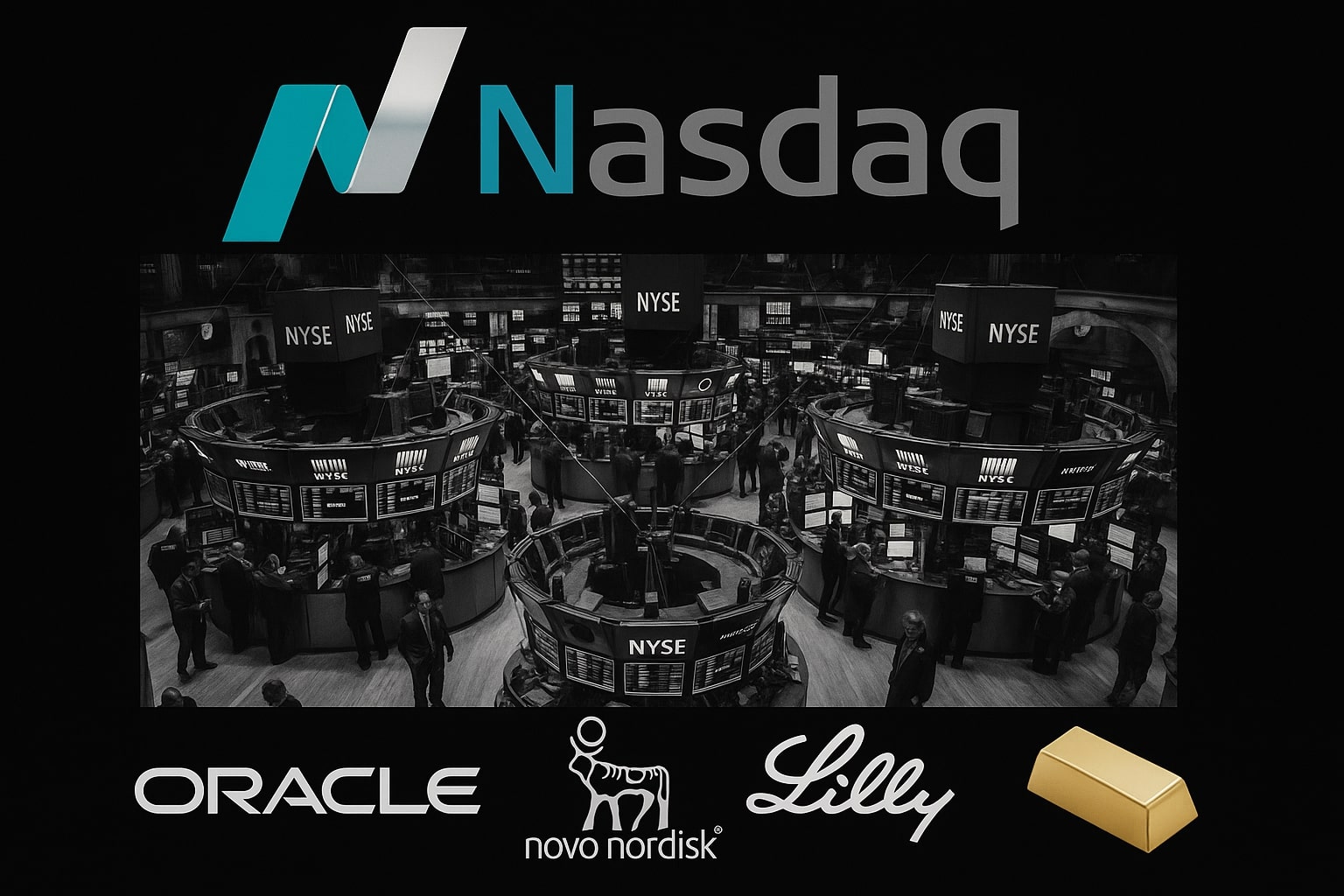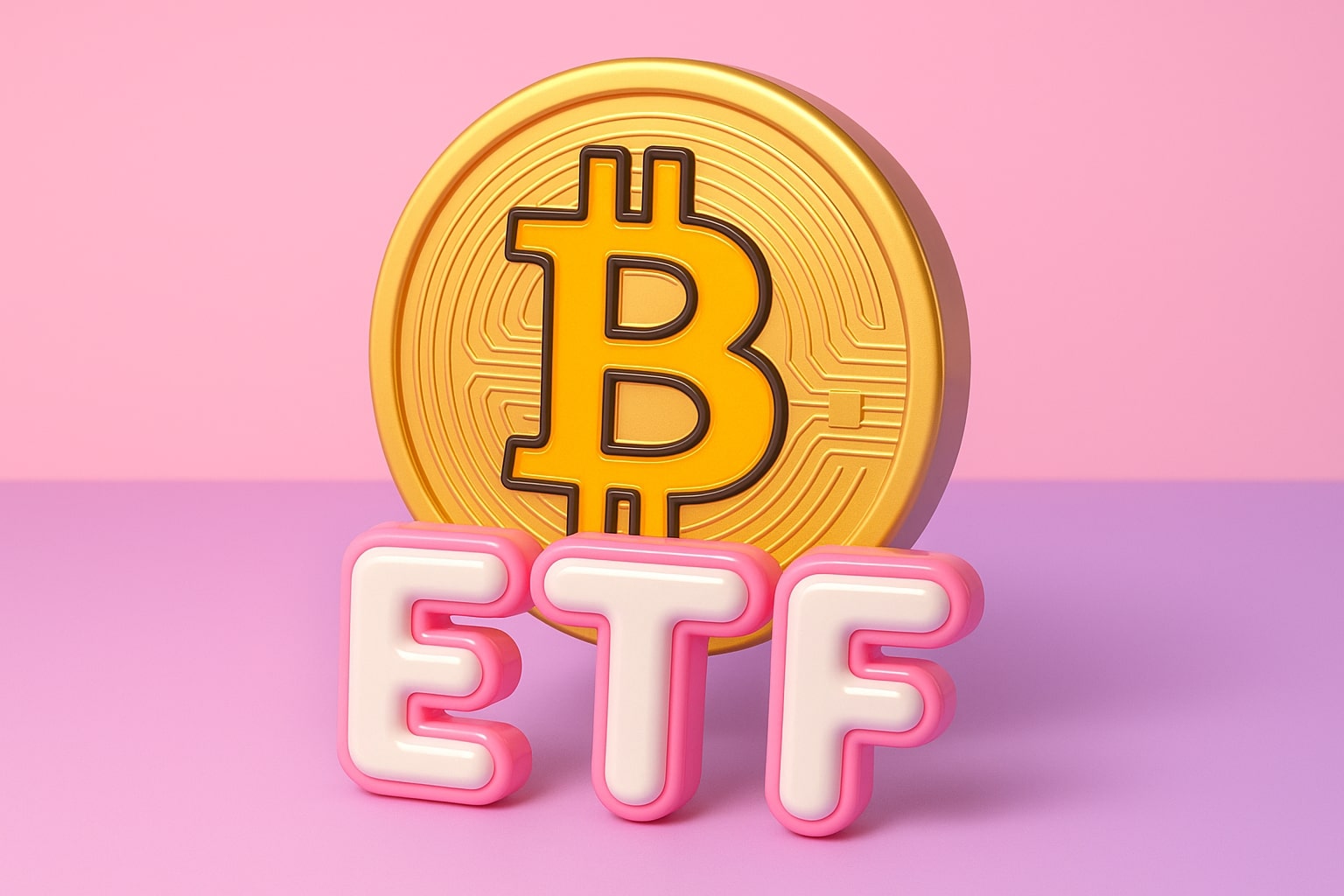
Stock Market Today - Dow 45,975 as ZION, JEF Rebound, Gold Tops $4,330, NVO, LLY Sink
Regional banks ZION and WAL recover after loan losses; DE upgraded to Buy, MU falls 3%, Bitcoin slides to $105,600 as gold surges on Fed cut bets | That's TradingNEWS
Wall Street Battles Credit Fears, Tariff Uncertainty, and Safe-Haven Rush
U.S. equity markets closed another volatile session on Friday, caught between optimism over potential trade de-escalation and renewed anxiety about credit quality in regional banks. The Dow Jones Industrial Average (^DJI) managed to edge 0.05% higher at 45,975.48, reversing early losses that followed Thursday’s sharp 300-point decline. The S&P 500 (^GSPC) slipped 0.2% to 6,614.95, while the Nasdaq Composite (^IXIC) retreated 0.3% to 22,447.82 as large-cap technology names and chip stocks weakened. Despite the turbulence, all three indices retained weekly gains—Dow +1.3%, S&P 500 +1.0%, Nasdaq +1.6%—helped by a strong start to third-quarter earnings and resilient labor data.
The smaller-cap Russell 2000 (^RUT) lost 1.1% after touching its highest level in months earlier in the week, underscoring a shift away from speculative high-beta names that have driven much of 2025’s rally. Market anxiety remained palpable with the Cboe Volatility Index (^VIX) briefly topping 27 for the first time since April before retreating to 24.6. While the move suggested fading panic, it marked the fifth straight session with intraday swings exceeding 1.5%, breaking the calm that dominated most of Q3 trading.
Regional Banks Face Renewed Credit Pressure
Credit stress dominated Wall Street’s narrative as regional lenders became the epicenter of investor fear. Zions Bancorp (ZION)’s disclosure of a $50 million loan charge-off tied to two allegedly fraudulent borrowers reignited debate about credit quality across the banking system. ZION collapsed 13% Thursday before recovering roughly 4% on Friday after Baird argued the sell-off exaggerated the actual exposure relative to the bank’s balance sheet. Western Alliance Bancorp (WAL) followed a similar path, falling 10% and rebounding 3% the next day after filing a lawsuit over a separate fraudulent loan. The SPDR S&P Regional Banking ETF (KRE) rose 1.1% to $58.77, trimming part of Thursday’s 6% plunge but still ending the week lower.
Analysts at Oppenheimer upgraded Jefferies Financial Group (JEF) to outperform after its 11% sell-off on concerns about First Brands, an auto-parts manufacturer whose bankruptcy revealed $45 million in exposure. Jefferies rallied more than 6% Friday as bargain hunters returned. Fifth Third Bancorp (FITB) reported stronger-than-expected quarterly earnings, its net income rising despite higher credit-loss provisions tied to the collapse of subprime auto lender Tricolor. FITB gained 2%, while Comerica (CMA) and Truist Financial (TFC) also advanced 1%–2% after stressing that delinquencies remain contained.
Credit experts and regulators worked to downplay systemic fears. Moody’s managing director Marc Pinto said no evidence points to contagion, echoing JPMorgan Chase (JPM) CEO Jamie Dimon, who nevertheless warned that “when you see one cockroach, there are probably more.” The phrase quickly became shorthand for the new caution gripping regional bank investors. Despite mounting scrutiny, Friday’s price action suggested buyers were selectively stepping back into quality regional names as panic selling eased.
Safe-Haven Flows Drive Gold to Historic Records
As risk appetite faltered, capital rotated aggressively into havens. Gold (XAU/USD) soared to an unprecedented $4,330 per ounce, its seventh record close in two weeks, extending its weekly gain to over 7%. Silver joined the rally, peaking above $54, its highest since 1980. The precious-metal surge reflected both the drop in Treasury yields and the perception that ongoing U.S. credit jitters could slow the pace of economic expansion. The 10-year Treasury yield (^TNX) briefly fell to 3.94%, its lowest since April, before recovering to 4.00% as bargain hunters emerged. The 30-year (^TYX) hovered near 4.61%, while the 5-year (^FVX) settled around 3.59%.
The flight to safety also benefited sovereign bonds abroad. German Bund yields touched a four-month low at 2.52%, and Japanese government bonds saw the strongest bid since early summer. Analysts pointed out that with the U.S. Dollar Index (DX=F) falling for a fourth consecutive session to 98.3, non-yielding assets such as gold have regained relative appeal. Traders now price more than 53 basis points of Fed cuts before year-end, up from 46 bps earlier this week. The dovish bias, supported by Fed Governor Christopher Waller’s comments on measured easing, has reinforced gold’s momentum but may be nearing exhaustion given record speculative long positions.
Bitcoin and Oil Signal Diverging Risk Appetite
Digital assets once hailed as hedges failed to offer shelter. Bitcoin (BTC-USD) sank to $105,600, extending its monthly decline to roughly 17% and marking the lowest level since July. The retreat reflected both deleveraging and disappointment that crypto failed to act as “digital gold” during equity turmoil. Ether (ETH-USD) fell below $3,800, while BNB (BNB-USD) tumbled 11% after renewed technical disruptions at Binance triggered forced liquidations.
Commodity markets told a similar story of risk aversion. West Texas Intermediate (CL=F) slid under $57 a barrel, the weakest since 2021, pressured by excess supply and fresh demand downgrades from the International Energy Agency. Brent (BZ=F) followed suit, underscoring market skepticism that OPEC+ production discipline can offset the broader slowdown in global consumption.
Trump’s Policy Signals Reignite Trade Optimism
Market sentiment shifted mid-day after President Donald Trump softened his tone on China tariffs. He acknowledged that 100% duties on imported Chinese goods “are not sustainable,” sparking a rapid rebound in futures. The statement, combined with confirmation of a pending meeting with President Xi Jinping, revived expectations of renewed negotiations and lifted cyclical equities.
Automakers, among the biggest tariff casualties, reacted swiftly. General Motors (GM) rose 1%, Stellantis (STLA) added nearly 1%, and Ford Motor (F) held flat as investors anticipated Commerce Department approval of a five-year extension to reduced tariffs on imported parts. The auto sector’s resilience contrasted with pressure on pharmaceuticals after Trump vowed to slash drug prices. Novo Nordisk (NVO) dropped 4% to $53.84, and Eli Lilly (LLY) slid nearly 3% to $795.93 after the president said Ozempic’s monthly cost should fall from $1,000 to about $150.
Beyond tariffs, Trump’s remarks about the federal government’s “ample reserves” and the competence of his new financial team, including Treasury Secretary Scott Bessent, sought to calm fears of a replay of the 2023 banking turmoil. His assurance that “this team will stay way ahead of the curve” provided short-term relief but left markets hungry for concrete policy clarity.
Corporate Landscape: Earnings Deliver Mixed Signals
Corporate news provided both headwinds and bright spots. American Express (AXP) exceeded forecasts, driven by continued strength in high-income spending and premium card demand. CEO Steve Squeri highlighted a global delinquency rate of just 1.3%, notably lower than peers, suggesting consumer credit remains stable at the top of the income spectrum.
In industrials, Deere & Co (DE) advanced after UBS upgraded the stock to Buy, raising its target from $535 to $545. Analyst Steven Fisher argued that 2026 will likely mark the trough of the agricultural machinery cycle before an earnings rebound in 2027. Deere has gained 8% year-to-date, reflecting investor belief that sentiment in the sector is bottoming.
Technology names moved unevenly. Micron Technology (MU) fell over 3% to $196.34 after reports it will withdraw from China’s server-memory market, deepening the long-term cost of Beijing’s 2023 ban. Meanwhile, Oracle (ORCL) slipped 2.4% despite reaffirming a 31% compound annual revenue growth outlook and unveiling a new cloud partnership with Meta Platforms (META).
Transportation also contributed to the week’s volatility. CSX (CSX) shares climbed 2% following EPS of $0.44 versus estimates of $0.42, supported by efficiency gains that offset lower coal shipments. Interactive Brokers (IBKR), despite a 21% jump in net-interest income to $967 million, fell nearly 3% as guidance hinted at moderation ahead.
Read More
-
VIG ETF Hits $220.60 as Dividend Growth and $116.6B AUM Signal Renewed Upside
09.12.2025 · TradingNEWS ArchiveStocks
-
XRP ETFs Cross $1.2B AUM as XRPI at $12.34 and XRPR $17.31 Signal Accelerating Institutional Demand
09.12.2025 · TradingNEWS ArchiveCrypto
-
Natural Gas Prices Slide to $4.60 (NG=F) After Two-Day 13% Drop — EIA Still Sees $5 Average
09.12.2025 · TradingNEWS ArchiveCommodities
-
USD/JPY Price Forecast - Pairs Steadies Near 156.90 as Fed Cut and Yield Gap Shape Path Toward 157.80
09.12.2025 · TradingNEWS ArchiveForex
Economic Indicators and the Policy Backdrop
While the government shutdown delayed official releases, private data filled the void. Initial jobless claims likely fell to ≈215,000, down from 234,000, according to state-level filings, implying that layoffs remain limited even as credit stress rises. Continuing claims hovered near 1.92 million, signaling that labor demand remains firm enough to complicate expectations of rapid Fed easing.
The shutdown itself—now entering its third week—has started to affect sentiment on Main Street, with suspended federal paychecks curbing spending among lower-income households. In contrast, upper-income consumers, who account for the bulk of discretionary demand, remain robust. Fed Beige Book data showed luxury travel, automotive, and premium retail activity outperforming mid-tier categories. Bank of America Institute data confirmed that the top third of earners increased spending 2.6% YoY, while the bottom third managed only 0.6%.
Monetary policy expectations shifted further dovish after multiple Fed officials endorsed gradual cuts. Traders in futures markets now anticipate at least two quarter-point reductions before December. The U.S. dollar’s fourth consecutive weekly decline, coupled with falling yields, has made U.S. assets comparatively less attractive to foreign capital, though equity inflows from global institutions continued on weakness.
Global and Cross-Asset Contagion Dynamics
The wave of concern over U.S. credit quality rippled through international markets. Europe’s Stoxx 600 Banks Index dropped 3%, its steepest fall since August 1, as Deutsche Bank (DB) plunged 6.4%, Barclays (BCS) fell 5.2%, and BNP Paribas (BNP) declined nearly 4%. In Asia, Shanghai Composite −2%, Hang Seng −2.5%, and Nikkei 225 −1.4%, reflecting risk aversion ahead of expected U.S.–China talks.
The synchronized weakness reinforced safe-haven demand. Treasury auction coverage ratios hit their highest in six months, and demand for short-dated bills surged amid uncertainty about the budget impasse. The 2-to-10-year yield spread narrowed toward −34 bps, its flattest in two months, signaling an improved outlook for growth even as investors hedge against near-term volatility.
Investor Sentiment and Positioning
Sentiment indicators illustrate a fragile equilibrium. The CNN Fear and Greed Index climbed from extreme fear to fear, while option volumes on the S&P 500 skewed toward downside hedging. However, institutional fund flows showed net inflows into technology and industrial ETFs, suggesting that professional investors are selectively buying dips rather than exiting risk wholesale.
Market strategist Dan Niles reiterated that regional-bank stress appears episodic, not systemic, contrasting sharply with 2008. Similarly, Adam Crisafulli of Vital Knowledge highlighted that credit quality outside the auto sector remains “better than anticipated.” Still, Charles Schwab’s Liz Ann Sonders warned that speculative excess persists in pockets such as quantum computing and drone technology, primarily within the Russell 2000 (^RUT), where valuations have detached from fundamentals.
Outlook and Strategic View
Heading into next week, the market’s tug-of-war between fear and fundamentals remains unresolved. Earnings from Bank of America (BAC), Morgan Stanley (MS), State Street (STT), and Ally Financial (ALLY) will determine whether the credit narrative expands or fades. A sustained pullback in yields combined with constructive corporate results could re-ignite rotation into cyclicals, while further loan revelations might push the S&P 500 back toward the 6,500 support region.
The fundamental divide in U.S. consumption—strong spending by wealthy households and restraint among lower-income groups—suggests a soft-landing path remains plausible but uneven. The market’s tolerance for policy uncertainty, from tariffs to the budget stalemate, is narrowing, yet investors continue to reward resilience over panic.
Trading News Assessment
From an analytical standpoint, the near-term stance tilts cautiously bullish for major indices as tariff rhetoric cools and Fed expectations stay supportive.
-
Dow Jones (^DJI) and S&P 500 (^GSPC): Short-term Buy bias while volatility normalizes below VIX 25.
-
Nasdaq (^IXIC): Neutral, pending clarity on chip-sector guidance after Micron (MU) and Oracle (ORCL) updates.
-
Regional Banks (ZION, WAL, CMA, FITB): Speculative Buy for value investors; credit risks remain localized, not systemic.
-
Gold (XAU/USD): Hold / Trim positions near $4,300 as technical overextension signals potential pullback.
-
Bitcoin (BTC-USD): Sell / Avoid until sustained close above $110,000 re-establishes trend support.
-
Deere (DE): Buy on early-cycle recovery expectations.
-
Novo Nordisk (NVO) and Eli Lilly (LLY): Hold pending clarity on U.S. drug-pricing policy.
Overall, the American equity market stands at a pivotal juncture—caught between the reassurance of steady corporate balance sheets and the unease of a credit undercurrent yet to surface fully. Traders are no longer complacent, but neither are they capitulating. As volatility cools and fundamentals reassert themselves, disciplined positioning—not fear—will decide the fourth quarter’s trajectory.


















